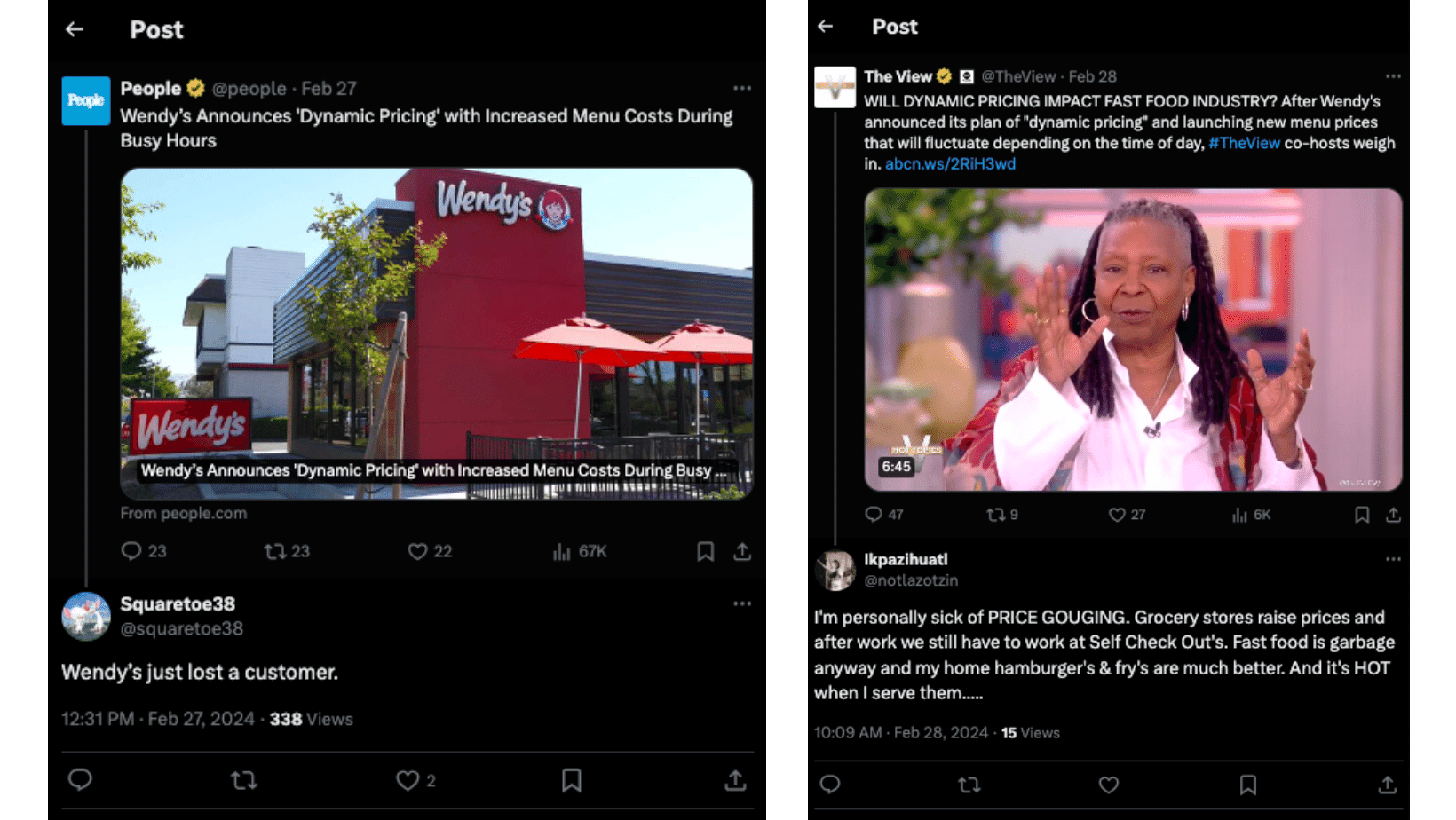How to Implement Dynamic Pricing Responsibly: TGI Fridays Case Study
“I hope the government hammers you for price gouging.”
“Prices are already outrageously high for fast food.”
“This type of crap will guarantee I never go back.”
Based on these (real) responses to Wendy’s dynamic pricing announcement back in February, it’s clear that consumers have very strong opinions about this restaurant pricing strategy.
But how much of that comes from misinterpretations of dynamic pricing?
Or from thinking that dynamic pricing is the same as the pandemic price gouging we all saw?
Or even from not believing that dynamic pricing can be responsible, ethical, and effective?
If you ask us… a lot of it does.
There are tons of restaurants already implementing dynamic pricing in ethical, responsible, and profitable ways — we just don’t talk about them as much as we do the “bad” examples.
So, in this blog — which is part 2 of our dynamic pricing series, by the way — we’ll be shifting the spotlight to the “good” guys, focusing our discussion on:
- How dynamic pricing can (and should) be ethical and responsible
- How TGI Fridays profits from ethical, responsible dynamic pricing
- How your restaurant can explore ethical dynamic pricing with Craver
A Crash Course of Dynamic Pricing in Restaurants
Before we dive into any new dynamic pricing concepts, a quick refresher on what we covered in part 1 wouldn’t hurt, right?
Here’s your TL;DR on what we covered in part 1.
- Dynamic pricing: a strategy where businesses increase or decrease their prices based on factors like customer interest and market demand.
- 3 commonly used dynamic pricing strategies
- Surge/Demand Pricing → E.g. Higher Uber prices after a sports game
- Value-Based Pricing → E.g. Higher food & bev prices at a concert
- Time-Based/Peak Pricing → E.g. Flight prices increasing during the holidays
- Dynamic pricing ≠ price gouging
- Price gouging: when a business raises its prices to “unfair levels” without cause
For a more general overview of dynamic pricing in restaurants – including definitions of different strategies and a pros and cons list – check out the first part of our dynamic pricing series!
Consumer Perspective on Dynamic Pricing
Based on some of the quotes you read at the beginning of this blog, it’s pretty safe to say there are some strong negative opinions on dynamic pricing.

But that dynamic distaste isn’t just about “outrageously high” fast food prices; it’s a much more nuanced issue than that. The (mostly) negative customer stance on dynamic pricing is the result of several different factors, like:
- A widespread misinterpretation of “dynamic pricing”
- 52% of customers think dynamic pricing is the same thing as price gouging
- An inability to schedule around time-based deals
- 77% of customers have low-to-moderate flexibility with meal times
- A hard-and-fast budget for restaurants/eating out
- 45% of customers have low-to-no flexibility with restaurant budgets
So, do those stats mean dynamic pricing is a lost cause for the restaurant industry, then?
Yes. If you’re not doing it the “right” way, that is.
Luckily, implementing an ethical and responsible dynamic pricing strategy is so much easier than the “bad” examples make it seem — because it’s as easy as 1-2-3.
3 Ways to Ethically and Responsibly Implement Dynamic Pricing
1. Be transparent and direct about your dynamic pricing
Contrary to popular belief, not everyone likes surprises… especially when the surprising thing is their dinner bill.
As soon as you know the effective date of your dynamic pricing strategy, tell your customers. Then tell them a second time. And maybe a third or fourth time after that, too. By the time your dynamic pricing rolls out, there shouldn’t be anyone surprised about the date it’s happening.
You’ll also want to be candid about the “why” and the “what” behind your dynamic pricing.
Your customers will want to know two things: 1) Why you’re changing the prices, and 2) What difference it’s going to make for them. Can they expect better food quality or stronger customer service? Maybe an increase in new offerings? Either way, your “why” and your “what” should both be transparently shared with your customers.
Remember: no surprises.
Action Items:
- Inform customers early (and often)
- Share the “why” & the “what”
2. Be specific and narrow with your price changes
According to a 2023 Capterra survey, three in 10 customers are willing to pay peak prices — A.K.A. elevated prices at the busiest times — from restaurants they already order from.
But, of those three customers, only a single person would be willing to pay 10% over the regular price. Combine that hard stop at 10% with the general inflexibility of customer food budgets, and you’ve just revealed a golden nugget of wisdom — the specific, narrow margin you need to use to inform your dynamic pricing.
Now, at first glance, it sounds like you’re losing customers… but think about it this way.
You’re raising your prices at times when you’re already busy. So, the people who do stay are willing to pay a bit more, and the people who don’t stay won’t affect your bottom line too much, because you’re already lined up out the door.
The same is true for lowering your prices during slow times, too. The folks who show up for the discount give you business you wouldn’t have gotten otherwise, and the folks who don’t show up? Well, you wouldn’t have seen them anyway!
And, one of the nicest things about keeping your margins narrow? It’s good for your customers. They feel respected – because you adhered to the margins they’re comfortable with – and they’re getting a unique experience (whether it’s a meal during a super busy time, or a discount during a lull).
The truest version of a win-win.
Action Items:
- Keep price increases narrow
- Let customer data guide your increases
3. Be flexible, open, and ready to pivot
In part 1 of our dynamic pricing series, we shared the success Applebee’s has found through twice-daily happy hours and 50% off apps.
But, if your restaurant were to try out twice-daily happy hours and Dollaritas, there’s no guarantee you’d see the same 7.7% sales increase that Applebee’s did. And that’s because very few things in the restaurant industry — or any industry, really — are one-size-fits-all.
Including dynamic pricing.
So, if your happy hour numbers make you less-than-happy, consider what that means for your dynamic pricing strategy. Maybe your customers aren’t big on alcohol, or they’re busy during your happy hours. Look at what your customers are telling you through their purchases, and don’t be afraid to give something else a try.
That’s why the most ethical and responsible way to approach dynamic pricing is with flexibility, open-mindedness, and a willingness to pivot based on your specific data.
Because your customers' happiness should always come first.
Action Items:
- Keep an open mind and a flexible approach
- Let customer data guide your adjustments
Ethical, Responsible Dynamic Pricing at TGI Fridays: A Mini Case Study
Now that we know ethical, responsible dynamic pricing can be done (in 3 easy steps, might I add) let’s take a look at a restaurant that’s already been doing it.
TGI Fridays is a bar and grill chain, offering “authentic American food and legendary drinks, served with genuine personal service.”
Created to celebrate the “liberating spirit of ‘Friday’” all week long, TGI Fridays has become a global name, with 850 restaurants in over 55 countries, and a reputation for stellar dynamic pricing strategies.
TGI Fridays offers a ton of different “dynamically priced” options, including:
- $5 Happy Hour — premium cocktails for just $5
- Lunch deals — 10 different lunch entrees for $10
- Wing Mondays — 50-cent wings from 5 PM to close
- “Claus for Celebration” — exclusive, limited edition menu

Profit-wise, TGI Fridays’ dynamic pricing options have definitely been successful; profits rose by 4% in December 2023, just one month after their “Clause for Celebration” menu went live.
Ethics- and responsibility-wise, we think they’ve been successful, too.
TGI Fridays’ dynamic pricing is:
- Transparent and direct — Both the prices and the time constraints for the deals are crystal clear for the customer.
- Specific and narrow — Many of their deal prices are $10 or less, and they’re always explicitly stated.
- Flexible and open-minded — The brand frequently experiments with new deals ($5 Happy Hour launched just 6 weeks ago).
And, the brand’s commitment to strong, responsible dynamic pricing has paid off in other, more growth-focused ways, too.
Recently, TGI Fridays announced a nationwide reorganization, aimed at improving customer experience through newly optimized and streamlined operations.
“Our top priority has always been delivering a superior experience for each and every TGI Fridays guest,” said Ray Risley, TGI Fridays’ U.S. President and COO. “[We’ve] identified opportunities to optimize and streamline our operations to ensure we are best positioned to meet – and exceed – on that brand promise.”
How to Implement Dynamic Pricing with Craver
So, we can all agree that dynamic pricing is only worth implementing if it's done ethically and responsibly.
Luckily, that’s the only way we do dynamic pricing at Craver.
With a custom-branded mobile app from Craver, you can tell customers when to expect price changes — and what those price changes will look like — with push notifications on your app or a pop-up on your kiosk display.
Then, once your customers know what’s coming, our intuitive interface means you can experiment as much as you want to see what sticks (and what doesn’t). Add an off-peak Happy Hour to your app or test out an exclusive lunch deal on your kiosk… the choice is yours!
At Craver, we know that dynamic pricing can be an effective strategy for restaurants.
Why shouldn’t it be easy to implement, too?
Book a demo today to find out how a Craver app can increase your restaurant's revenue by up to 40%.
.png?width=86&name=Untitled%20design%20(84).png)




